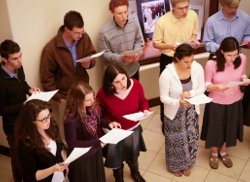- Home
-
About
 Fidelity & Excellence
Fidelity & ExcellenceThomas Aquinas College is unique among American colleges and universities, offering a faithfully Catholic education comprised entirely of the Great Books and classroom discussions.
-
A Liberating Education
 Truth Matters
Truth MattersTruth, and nothing less, sets men free; and because truth is both natural and supernatural, the College’s curriculum aims at both natural and divine wisdom.
-
A Catholic Life
 Under the Light of Faith
Under the Light of FaithThe intellectual tradition and moral teachings of the Catholic Church infuse the whole life of Thomas Aquinas College, illuminating the curriculum and the community alike.
-
Admission & Aid
 Is TAC Right for You?
Is TAC Right for You?Do you enjoy grappling with complex questions? Are you willing to engage in discussions about difficult concepts, with the truth as your ultimate goal?
-
Students & Parents
 Mind, Body & Spirit
Mind, Body & SpiritThere is always something to do at TAC — something worthwhile, something fulfilling, and something geared toward ever-greater spiritual and intellectual growth.
-
Alumni & Careers
 What Can You Do with a Liberal Education?
What Can You Do with a Liberal Education?Nothing speaks more to the versatility of the College’s academic program than the good that our alumni are doing throughout the Church and the world.
- Search
- Giving
Audio: Junior Class Music Tutorial
During the last days of classes before final examinations, 31 Thomas Aquinas College juniors gathered in the rotunda of St. Thomas Hall to sing five hymns. The brief performance marked the latest chapter in a young but increasingly anticipated campus tradition.
The emphasis on singing, with the public performance at the end of the semester, is a new phenomenon, the inspiration of Dr. Phillip Wodzinski, a tutor on the College’s teaching faculty. After his first semester teaching the tutorial in the fall 2010, Dr. Wodzinski was eager to showcase his students’ achievements; so he arranged for the mid-afternoon performance in the College’s faculty and administration building — surprising and delighting passersby.
Below are audio clips of the juniors’ five end-of-the-year hymns, accompanied by Dr. Wodzinski’s description of each one. (Note: To download a clip, click on the down arrow in the audio player.)
“Once to Every Man and Nation”
1. Our first hymn uses a poem that American James Russell Lowell (1819-91) wrote in protest of the Mexican War. A look at the lyrics indicates the fittingness of this hymn as an anthem for faithful Christians of the present day. The hymn tune is “Hyfrydol” (Welsh for “happiness”), by R.H. Prichard (1811-87), as arranged by Ralph Vaughan Williams (who composed or arranged the harmonies for all five of our hymns). “Hyfrydol” is the well-known and much-loved tune set to the hymn, “Alleluia, Sing to Jesus,” but you will find the combination of this music with Lowell’s poem to be elevating as well. The tune is in F-major and remains in this key the whole time.
“Lord, Teach us to Pray Aright”
2. The next hymn comes which fixes words by James Montgomery (1771-1854) to music by Thomas Tallis (1515-1585). The tune is the first of nine melodies written by Tallis for Archbishop Parker’s Psalter. The key of F-minor brings out the meditative as well as the plaintive sense of the words. One or two tricky movements in the rhythm add to the interest.
“Drop, Drop, Slow Tears”
3. “Drop, Drop, Slow Tears” is set to “Song 46” by Orlando Gibbons (1583-1625), who was Tallis’ successor in the history of English music. Although slow and attached to the penitential words of Phineas Fletcher’s (1582-1650) sorrowful lyrics, the music is in a glorious and almost lush F-major; this allows us to hear the slowly building hope of the penitent woman — but it culminates in humility rather than in presumption.
“I Could Not Do Without Thee”
4. Changing the pace somewhat, “I Could Not Do Without Thee” pairs the relatively snappy “Gosterwood” (a traditional English folk melody) with the humble, hopeful lyrics of Frances Harergal (1836-1879). The majestic tune, in G-major, is better known for its pairing with the words, “The King of Glory Standeth,” but the present lyrics are rather lovely and, with their slight melancholy, make an interesting match with the tune.
“Disposer Supreme and Judge of the Earth”
5. Saving the biggest (though not the hardest, which is probably # 2 above) for last, is “Disposer Supreme and Judge of the Earth,” which is set to a tune (“Old 104th”) originally composed for Psalm 104 by Thomas Ravenscroft (1592-1635). The words to the present hymn, by Jean de Santeuil (1630-1697) and translated by Isaac Williams (1802-1865), pair nicely with our first hymn: Whereas “Once to every man and nation” looked at the moral-spiritual struggle on earth from the human perspective, and concluded with the suggestion of God “behind the dim unknown” and “within the shadow,” “Disposer Supreme” suggests a much more explicit depiction of God’s working out of His purpose. The first and fifth hymns make a nice pairing for two other reasons as well: Both are in a sort-of waltzy ¾ time, and “Hyfrydol” is in F-major while “Old 104th” is in D-minor, i.e. the relative minor of F-major (although the tune modulates from D-minor to F-major and only back to D-minor at the conclusion).
Posted May 7, 2012




